Analysis of HRM Trends, Challenges, and Practices in MNCs
VerifiedAdded on 2020/03/16
|12
|3629
|127
Report
AI Summary
This report provides an in-depth analysis of Human Resource Management (HRM) within Multinational Corporations (MNCs). It explores the evolving role of HRM in a globalized business environment, emphasizing the shift from a domestic to an international focus. The report identifies and discusses three major challenges faced by international HRM professionals: workplace diversity, talent management, and employee retention. Workplace diversity is examined in terms of its definition, importance, and the strategies for effective management, including diversity training and embracing diversity in leadership. Talent management is presented as a critical strategy for recruiting, training, and retaining skilled workers, with an emphasis on the impact of poor talent management on business outcomes. Employee retention is analyzed as a significant challenge, highlighting the importance of understanding employee motivations and expectations. The report also assesses how these trends and challenges impact various HRM practices, including employee selection, recruitment, compensation, performance appraisals, training and development, and repatriation needs. The analysis underscores the need for HRM to adapt to the changing business environment and effectively address these challenges to ensure the success of MNCs.
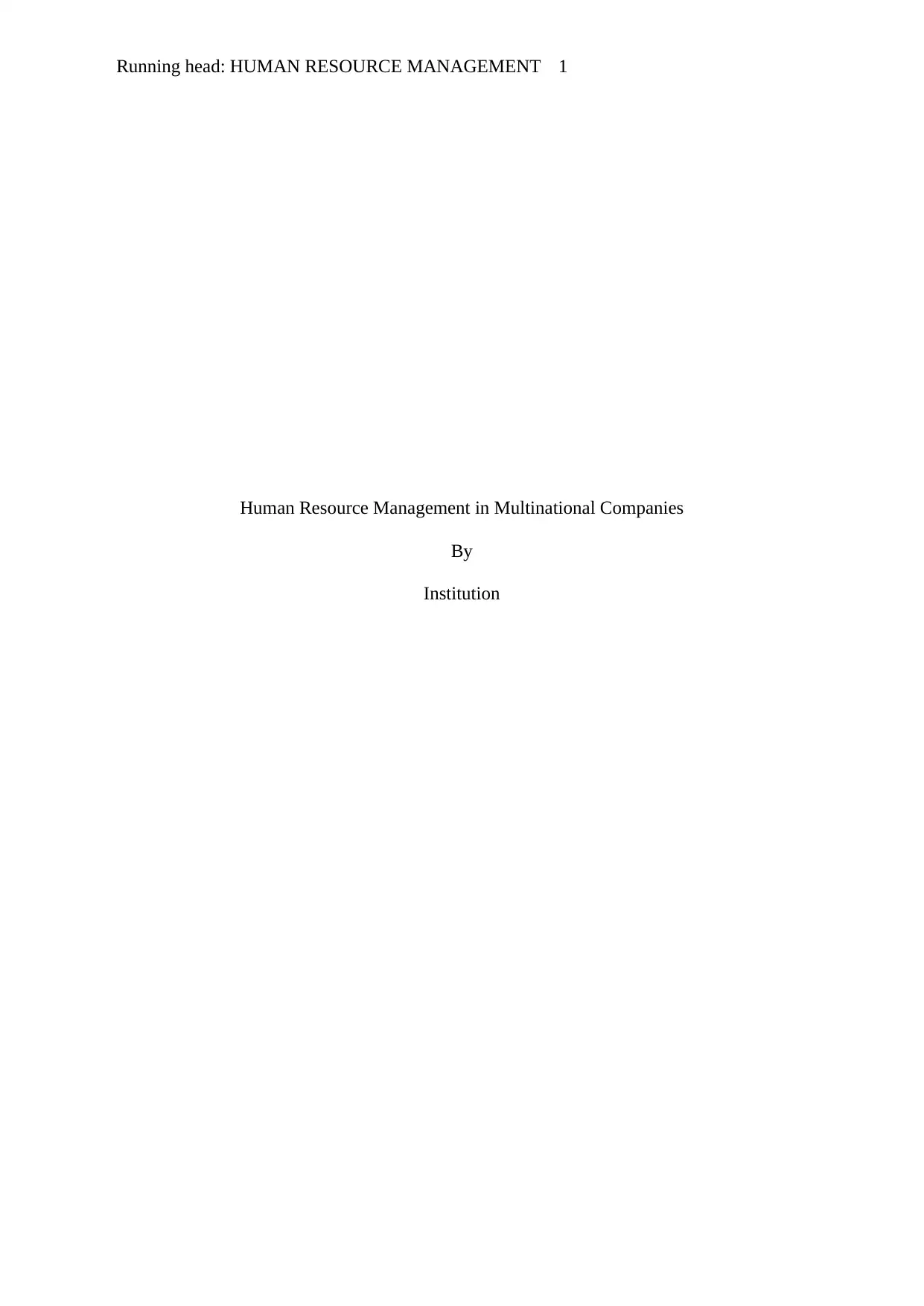
Running head: HUMAN RESOURCE MANAGEMENT 1
Human Resource Management in Multinational Companies
By
Institution
Human Resource Management in Multinational Companies
By
Institution
Paraphrase This Document
Need a fresh take? Get an instant paraphrase of this document with our AI Paraphraser
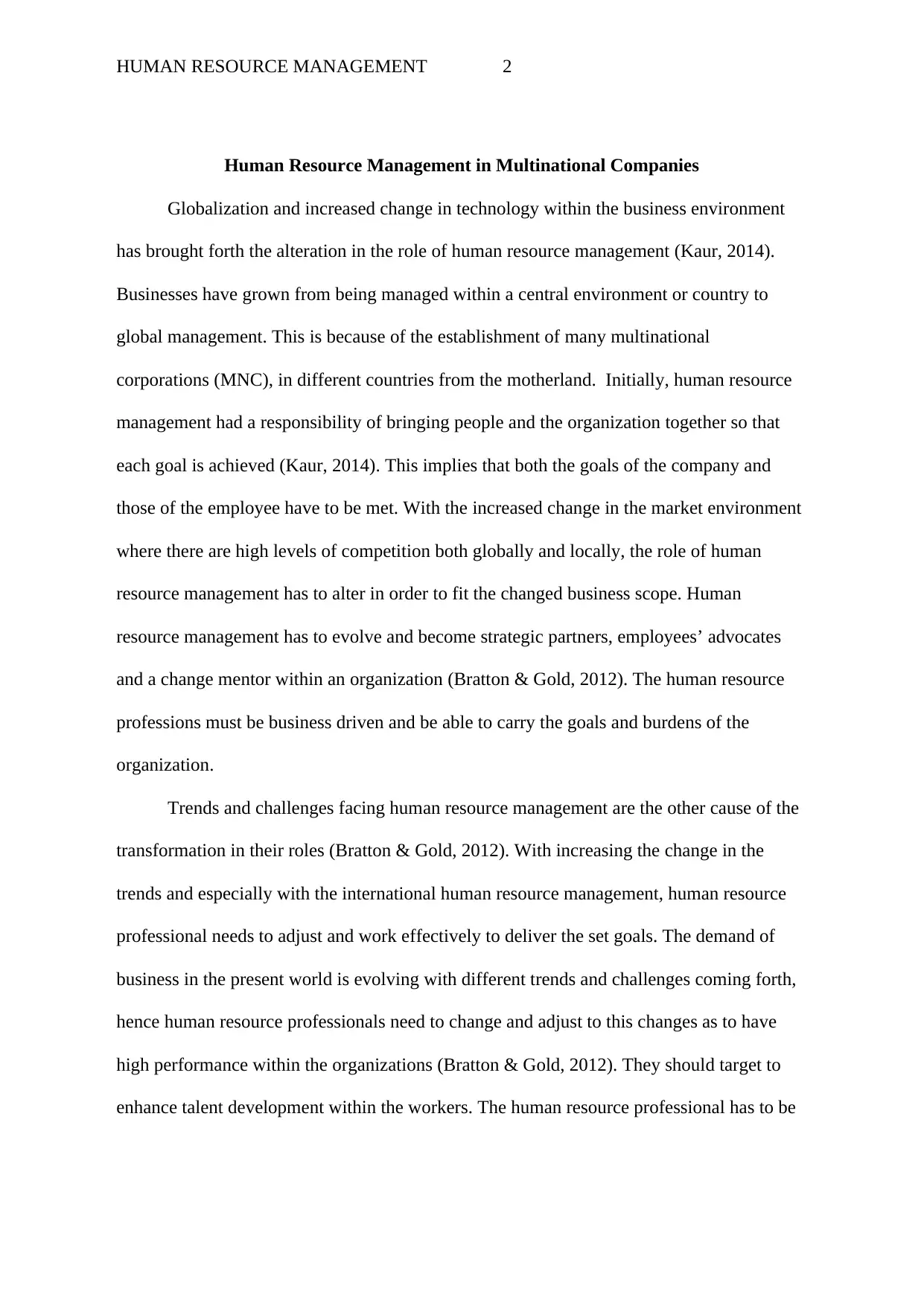
HUMAN RESOURCE MANAGEMENT 2
Human Resource Management in Multinational Companies
Globalization and increased change in technology within the business environment
has brought forth the alteration in the role of human resource management (Kaur, 2014).
Businesses have grown from being managed within a central environment or country to
global management. This is because of the establishment of many multinational
corporations (MNC), in different countries from the motherland. Initially, human resource
management had a responsibility of bringing people and the organization together so that
each goal is achieved (Kaur, 2014). This implies that both the goals of the company and
those of the employee have to be met. With the increased change in the market environment
where there are high levels of competition both globally and locally, the role of human
resource management has to alter in order to fit the changed business scope. Human
resource management has to evolve and become strategic partners, employees’ advocates
and a change mentor within an organization (Bratton & Gold, 2012). The human resource
professions must be business driven and be able to carry the goals and burdens of the
organization.
Trends and challenges facing human resource management are the other cause of the
transformation in their roles (Bratton & Gold, 2012). With increasing the change in the
trends and especially with the international human resource management, human resource
professional needs to adjust and work effectively to deliver the set goals. The demand of
business in the present world is evolving with different trends and challenges coming forth,
hence human resource professionals need to change and adjust to this changes as to have
high performance within the organizations (Bratton & Gold, 2012). They should target to
enhance talent development within the workers. The human resource professional has to be
Human Resource Management in Multinational Companies
Globalization and increased change in technology within the business environment
has brought forth the alteration in the role of human resource management (Kaur, 2014).
Businesses have grown from being managed within a central environment or country to
global management. This is because of the establishment of many multinational
corporations (MNC), in different countries from the motherland. Initially, human resource
management had a responsibility of bringing people and the organization together so that
each goal is achieved (Kaur, 2014). This implies that both the goals of the company and
those of the employee have to be met. With the increased change in the market environment
where there are high levels of competition both globally and locally, the role of human
resource management has to alter in order to fit the changed business scope. Human
resource management has to evolve and become strategic partners, employees’ advocates
and a change mentor within an organization (Bratton & Gold, 2012). The human resource
professions must be business driven and be able to carry the goals and burdens of the
organization.
Trends and challenges facing human resource management are the other cause of the
transformation in their roles (Bratton & Gold, 2012). With increasing the change in the
trends and especially with the international human resource management, human resource
professional needs to adjust and work effectively to deliver the set goals. The demand of
business in the present world is evolving with different trends and challenges coming forth,
hence human resource professionals need to change and adjust to this changes as to have
high performance within the organizations (Bratton & Gold, 2012). They should target to
enhance talent development within the workers. The human resource professional has to be
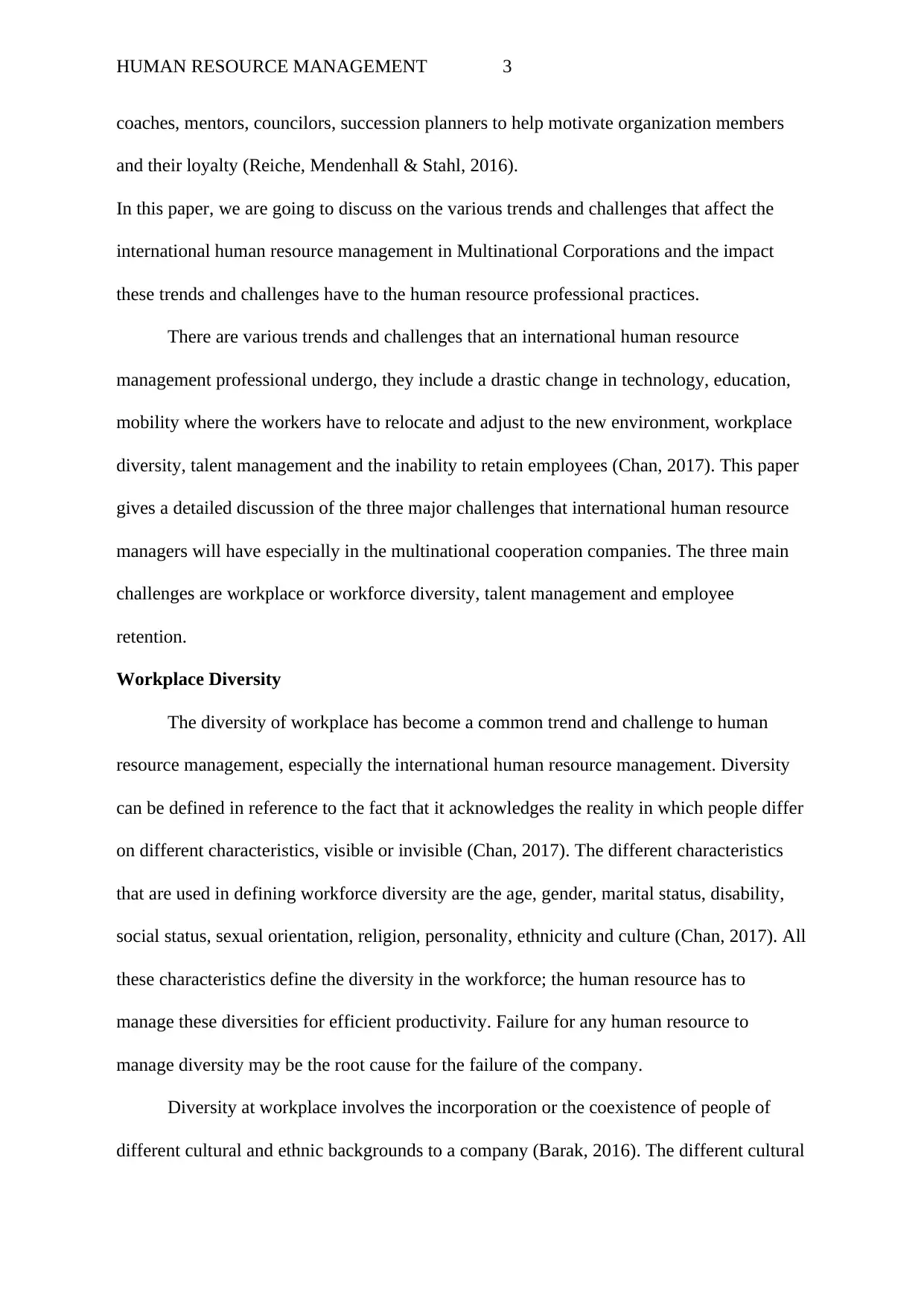
HUMAN RESOURCE MANAGEMENT 3
coaches, mentors, councilors, succession planners to help motivate organization members
and their loyalty (Reiche, Mendenhall & Stahl, 2016).
In this paper, we are going to discuss on the various trends and challenges that affect the
international human resource management in Multinational Corporations and the impact
these trends and challenges have to the human resource professional practices.
There are various trends and challenges that an international human resource
management professional undergo, they include a drastic change in technology, education,
mobility where the workers have to relocate and adjust to the new environment, workplace
diversity, talent management and the inability to retain employees (Chan, 2017). This paper
gives a detailed discussion of the three major challenges that international human resource
managers will have especially in the multinational cooperation companies. The three main
challenges are workplace or workforce diversity, talent management and employee
retention.
Workplace Diversity
The diversity of workplace has become a common trend and challenge to human
resource management, especially the international human resource management. Diversity
can be defined in reference to the fact that it acknowledges the reality in which people differ
on different characteristics, visible or invisible (Chan, 2017). The different characteristics
that are used in defining workforce diversity are the age, gender, marital status, disability,
social status, sexual orientation, religion, personality, ethnicity and culture (Chan, 2017). All
these characteristics define the diversity in the workforce; the human resource has to
manage these diversities for efficient productivity. Failure for any human resource to
manage diversity may be the root cause for the failure of the company.
Diversity at workplace involves the incorporation or the coexistence of people of
different cultural and ethnic backgrounds to a company (Barak, 2016). The different cultural
coaches, mentors, councilors, succession planners to help motivate organization members
and their loyalty (Reiche, Mendenhall & Stahl, 2016).
In this paper, we are going to discuss on the various trends and challenges that affect the
international human resource management in Multinational Corporations and the impact
these trends and challenges have to the human resource professional practices.
There are various trends and challenges that an international human resource
management professional undergo, they include a drastic change in technology, education,
mobility where the workers have to relocate and adjust to the new environment, workplace
diversity, talent management and the inability to retain employees (Chan, 2017). This paper
gives a detailed discussion of the three major challenges that international human resource
managers will have especially in the multinational cooperation companies. The three main
challenges are workplace or workforce diversity, talent management and employee
retention.
Workplace Diversity
The diversity of workplace has become a common trend and challenge to human
resource management, especially the international human resource management. Diversity
can be defined in reference to the fact that it acknowledges the reality in which people differ
on different characteristics, visible or invisible (Chan, 2017). The different characteristics
that are used in defining workforce diversity are the age, gender, marital status, disability,
social status, sexual orientation, religion, personality, ethnicity and culture (Chan, 2017). All
these characteristics define the diversity in the workforce; the human resource has to
manage these diversities for efficient productivity. Failure for any human resource to
manage diversity may be the root cause for the failure of the company.
Diversity at workplace involves the incorporation or the coexistence of people of
different cultural and ethnic backgrounds to a company (Barak, 2016). The different cultural
⊘ This is a preview!⊘
Do you want full access?
Subscribe today to unlock all pages.

Trusted by 1+ million students worldwide
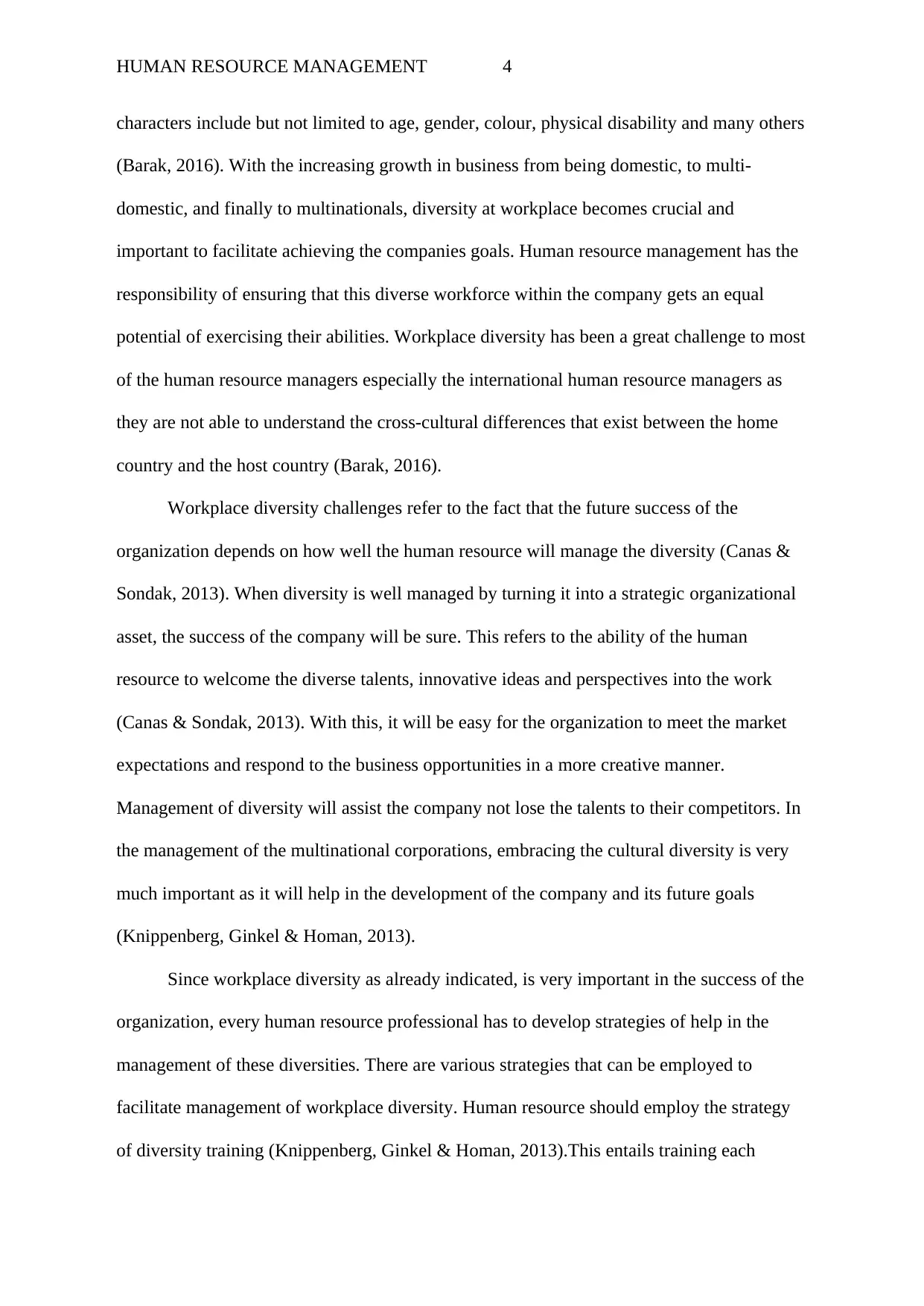
HUMAN RESOURCE MANAGEMENT 4
characters include but not limited to age, gender, colour, physical disability and many others
(Barak, 2016). With the increasing growth in business from being domestic, to multi-
domestic, and finally to multinationals, diversity at workplace becomes crucial and
important to facilitate achieving the companies goals. Human resource management has the
responsibility of ensuring that this diverse workforce within the company gets an equal
potential of exercising their abilities. Workplace diversity has been a great challenge to most
of the human resource managers especially the international human resource managers as
they are not able to understand the cross-cultural differences that exist between the home
country and the host country (Barak, 2016).
Workplace diversity challenges refer to the fact that the future success of the
organization depends on how well the human resource will manage the diversity (Canas &
Sondak, 2013). When diversity is well managed by turning it into a strategic organizational
asset, the success of the company will be sure. This refers to the ability of the human
resource to welcome the diverse talents, innovative ideas and perspectives into the work
(Canas & Sondak, 2013). With this, it will be easy for the organization to meet the market
expectations and respond to the business opportunities in a more creative manner.
Management of diversity will assist the company not lose the talents to their competitors. In
the management of the multinational corporations, embracing the cultural diversity is very
much important as it will help in the development of the company and its future goals
(Knippenberg, Ginkel & Homan, 2013).
Since workplace diversity as already indicated, is very important in the success of the
organization, every human resource professional has to develop strategies of help in the
management of these diversities. There are various strategies that can be employed to
facilitate management of workplace diversity. Human resource should employ the strategy
of diversity training (Knippenberg, Ginkel & Homan, 2013).This entails training each
characters include but not limited to age, gender, colour, physical disability and many others
(Barak, 2016). With the increasing growth in business from being domestic, to multi-
domestic, and finally to multinationals, diversity at workplace becomes crucial and
important to facilitate achieving the companies goals. Human resource management has the
responsibility of ensuring that this diverse workforce within the company gets an equal
potential of exercising their abilities. Workplace diversity has been a great challenge to most
of the human resource managers especially the international human resource managers as
they are not able to understand the cross-cultural differences that exist between the home
country and the host country (Barak, 2016).
Workplace diversity challenges refer to the fact that the future success of the
organization depends on how well the human resource will manage the diversity (Canas &
Sondak, 2013). When diversity is well managed by turning it into a strategic organizational
asset, the success of the company will be sure. This refers to the ability of the human
resource to welcome the diverse talents, innovative ideas and perspectives into the work
(Canas & Sondak, 2013). With this, it will be easy for the organization to meet the market
expectations and respond to the business opportunities in a more creative manner.
Management of diversity will assist the company not lose the talents to their competitors. In
the management of the multinational corporations, embracing the cultural diversity is very
much important as it will help in the development of the company and its future goals
(Knippenberg, Ginkel & Homan, 2013).
Since workplace diversity as already indicated, is very important in the success of the
organization, every human resource professional has to develop strategies of help in the
management of these diversities. There are various strategies that can be employed to
facilitate management of workplace diversity. Human resource should employ the strategy
of diversity training (Knippenberg, Ginkel & Homan, 2013).This entails training each
Paraphrase This Document
Need a fresh take? Get an instant paraphrase of this document with our AI Paraphraser
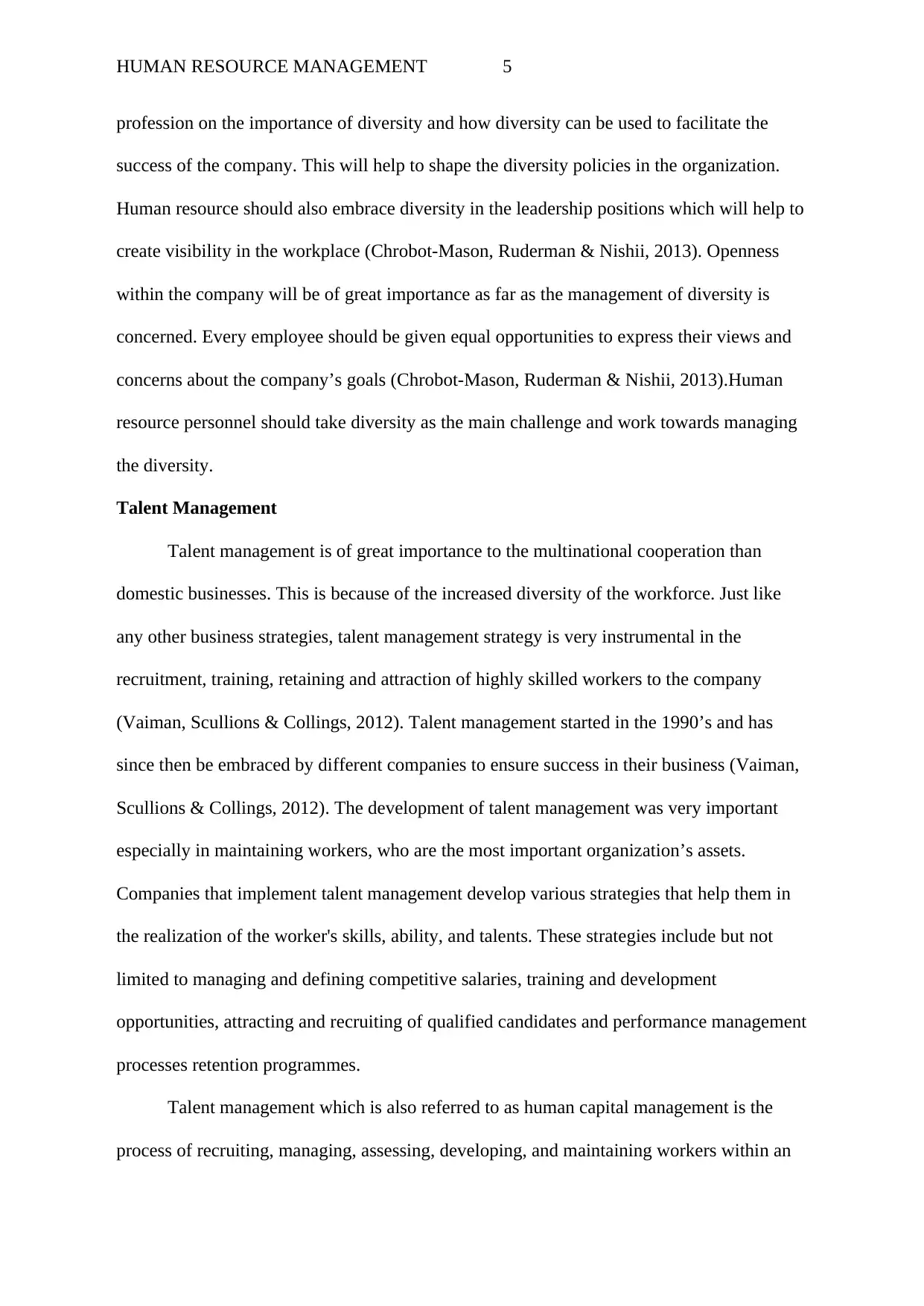
HUMAN RESOURCE MANAGEMENT 5
profession on the importance of diversity and how diversity can be used to facilitate the
success of the company. This will help to shape the diversity policies in the organization.
Human resource should also embrace diversity in the leadership positions which will help to
create visibility in the workplace (Chrobot-Mason, Ruderman & Nishii, 2013). Openness
within the company will be of great importance as far as the management of diversity is
concerned. Every employee should be given equal opportunities to express their views and
concerns about the company’s goals (Chrobot-Mason, Ruderman & Nishii, 2013).Human
resource personnel should take diversity as the main challenge and work towards managing
the diversity.
Talent Management
Talent management is of great importance to the multinational cooperation than
domestic businesses. This is because of the increased diversity of the workforce. Just like
any other business strategies, talent management strategy is very instrumental in the
recruitment, training, retaining and attraction of highly skilled workers to the company
(Vaiman, Scullions & Collings, 2012). Talent management started in the 1990’s and has
since then be embraced by different companies to ensure success in their business (Vaiman,
Scullions & Collings, 2012). The development of talent management was very important
especially in maintaining workers, who are the most important organization’s assets.
Companies that implement talent management develop various strategies that help them in
the realization of the worker's skills, ability, and talents. These strategies include but not
limited to managing and defining competitive salaries, training and development
opportunities, attracting and recruiting of qualified candidates and performance management
processes retention programmes.
Talent management which is also referred to as human capital management is the
process of recruiting, managing, assessing, developing, and maintaining workers within an
profession on the importance of diversity and how diversity can be used to facilitate the
success of the company. This will help to shape the diversity policies in the organization.
Human resource should also embrace diversity in the leadership positions which will help to
create visibility in the workplace (Chrobot-Mason, Ruderman & Nishii, 2013). Openness
within the company will be of great importance as far as the management of diversity is
concerned. Every employee should be given equal opportunities to express their views and
concerns about the company’s goals (Chrobot-Mason, Ruderman & Nishii, 2013).Human
resource personnel should take diversity as the main challenge and work towards managing
the diversity.
Talent Management
Talent management is of great importance to the multinational cooperation than
domestic businesses. This is because of the increased diversity of the workforce. Just like
any other business strategies, talent management strategy is very instrumental in the
recruitment, training, retaining and attraction of highly skilled workers to the company
(Vaiman, Scullions & Collings, 2012). Talent management started in the 1990’s and has
since then be embraced by different companies to ensure success in their business (Vaiman,
Scullions & Collings, 2012). The development of talent management was very important
especially in maintaining workers, who are the most important organization’s assets.
Companies that implement talent management develop various strategies that help them in
the realization of the worker's skills, ability, and talents. These strategies include but not
limited to managing and defining competitive salaries, training and development
opportunities, attracting and recruiting of qualified candidates and performance management
processes retention programmes.
Talent management which is also referred to as human capital management is the
process of recruiting, managing, assessing, developing, and maintaining workers within an
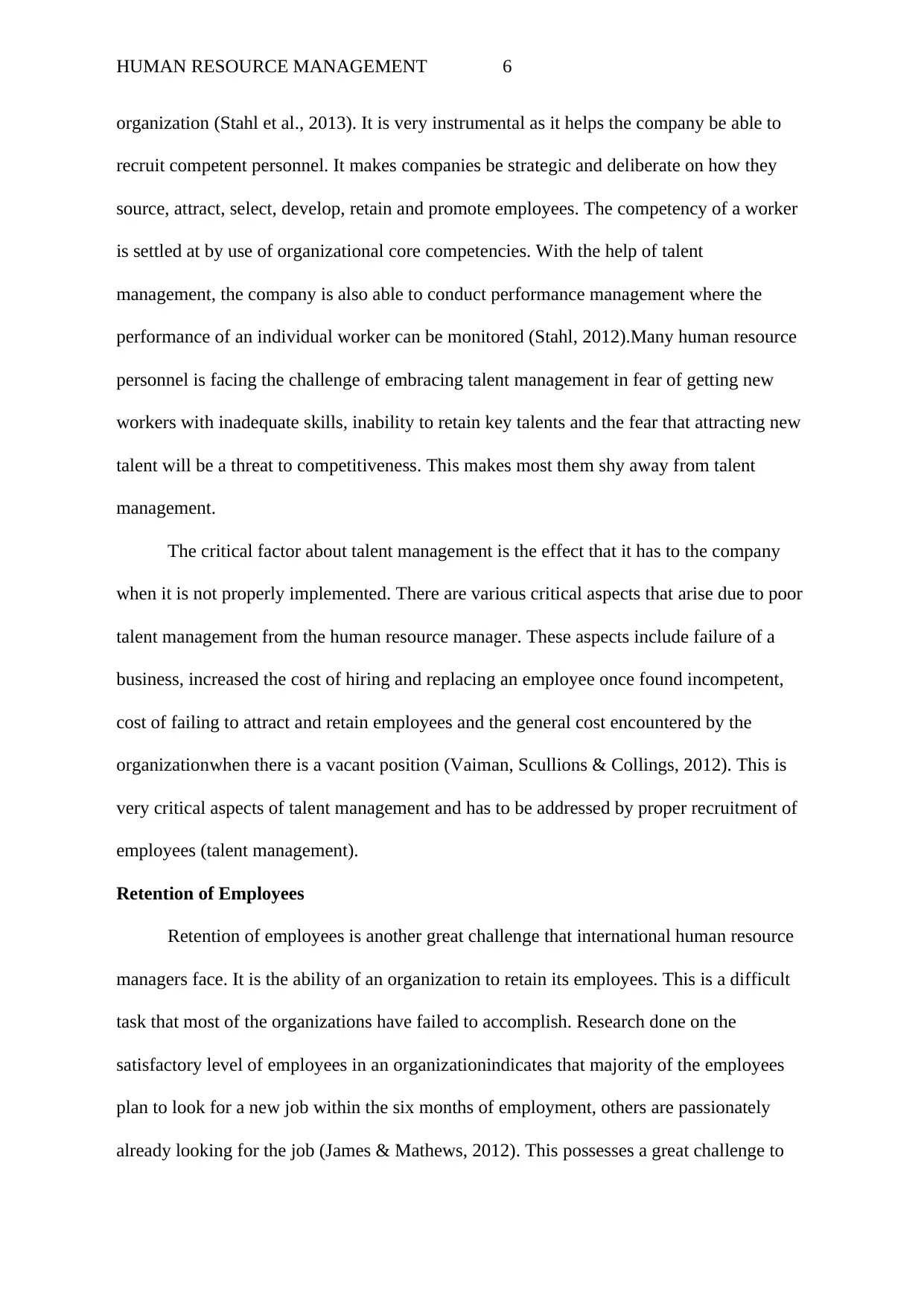
HUMAN RESOURCE MANAGEMENT 6
organization (Stahl et al., 2013). It is very instrumental as it helps the company be able to
recruit competent personnel. It makes companies be strategic and deliberate on how they
source, attract, select, develop, retain and promote employees. The competency of a worker
is settled at by use of organizational core competencies. With the help of talent
management, the company is also able to conduct performance management where the
performance of an individual worker can be monitored (Stahl, 2012).Many human resource
personnel is facing the challenge of embracing talent management in fear of getting new
workers with inadequate skills, inability to retain key talents and the fear that attracting new
talent will be a threat to competitiveness. This makes most them shy away from talent
management.
The critical factor about talent management is the effect that it has to the company
when it is not properly implemented. There are various critical aspects that arise due to poor
talent management from the human resource manager. These aspects include failure of a
business, increased the cost of hiring and replacing an employee once found incompetent,
cost of failing to attract and retain employees and the general cost encountered by the
organizationwhen there is a vacant position (Vaiman, Scullions & Collings, 2012). This is
very critical aspects of talent management and has to be addressed by proper recruitment of
employees (talent management).
Retention of Employees
Retention of employees is another great challenge that international human resource
managers face. It is the ability of an organization to retain its employees. This is a difficult
task that most of the organizations have failed to accomplish. Research done on the
satisfactory level of employees in an organizationindicates that majority of the employees
plan to look for a new job within the six months of employment, others are passionately
already looking for the job (James & Mathews, 2012). This possesses a great challenge to
organization (Stahl et al., 2013). It is very instrumental as it helps the company be able to
recruit competent personnel. It makes companies be strategic and deliberate on how they
source, attract, select, develop, retain and promote employees. The competency of a worker
is settled at by use of organizational core competencies. With the help of talent
management, the company is also able to conduct performance management where the
performance of an individual worker can be monitored (Stahl, 2012).Many human resource
personnel is facing the challenge of embracing talent management in fear of getting new
workers with inadequate skills, inability to retain key talents and the fear that attracting new
talent will be a threat to competitiveness. This makes most them shy away from talent
management.
The critical factor about talent management is the effect that it has to the company
when it is not properly implemented. There are various critical aspects that arise due to poor
talent management from the human resource manager. These aspects include failure of a
business, increased the cost of hiring and replacing an employee once found incompetent,
cost of failing to attract and retain employees and the general cost encountered by the
organizationwhen there is a vacant position (Vaiman, Scullions & Collings, 2012). This is
very critical aspects of talent management and has to be addressed by proper recruitment of
employees (talent management).
Retention of Employees
Retention of employees is another great challenge that international human resource
managers face. It is the ability of an organization to retain its employees. This is a difficult
task that most of the organizations have failed to accomplish. Research done on the
satisfactory level of employees in an organizationindicates that majority of the employees
plan to look for a new job within the six months of employment, others are passionately
already looking for the job (James & Mathews, 2012). This possesses a great challenge to
⊘ This is a preview!⊘
Do you want full access?
Subscribe today to unlock all pages.

Trusted by 1+ million students worldwide
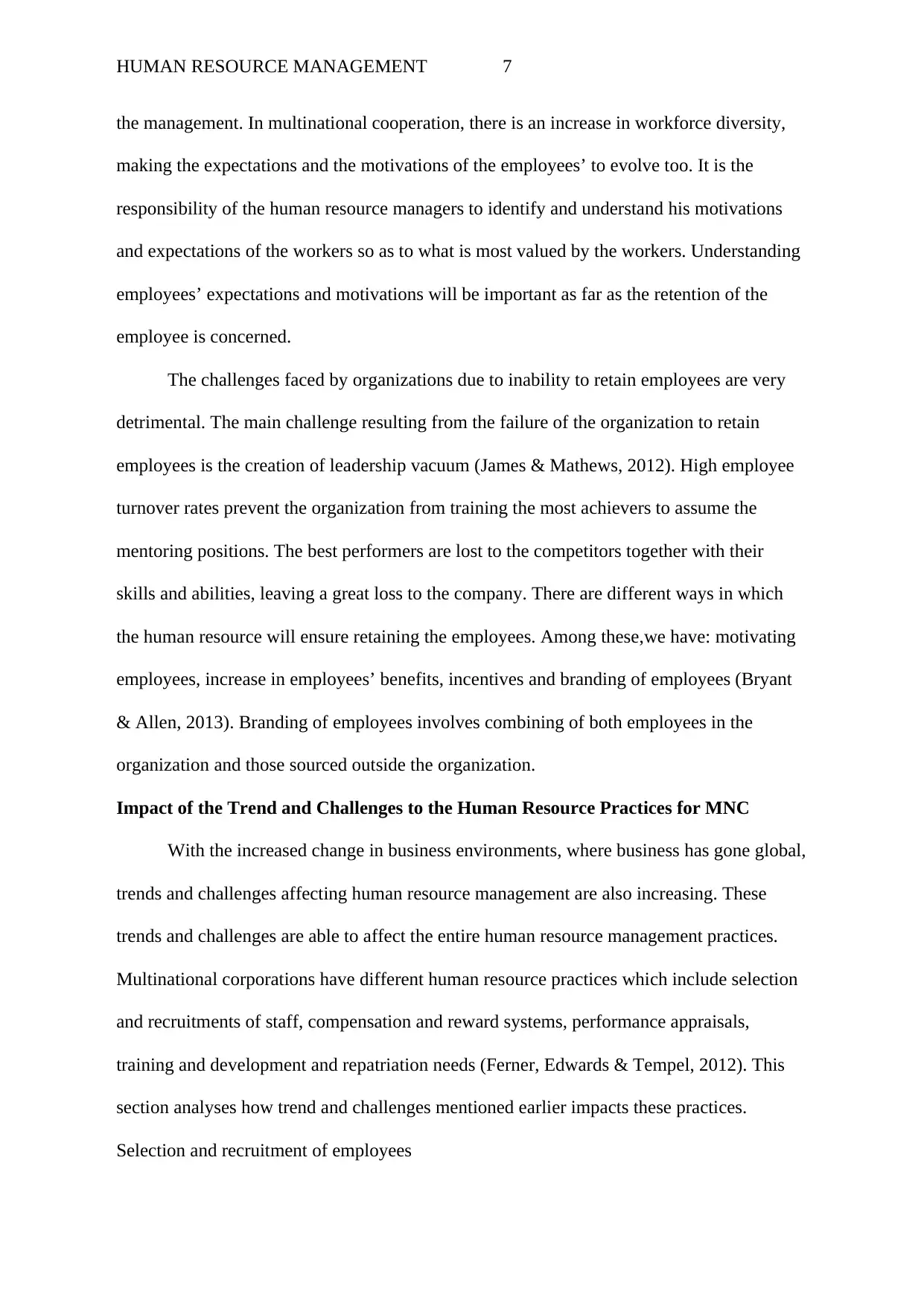
HUMAN RESOURCE MANAGEMENT 7
the management. In multinational cooperation, there is an increase in workforce diversity,
making the expectations and the motivations of the employees’ to evolve too. It is the
responsibility of the human resource managers to identify and understand his motivations
and expectations of the workers so as to what is most valued by the workers. Understanding
employees’ expectations and motivations will be important as far as the retention of the
employee is concerned.
The challenges faced by organizations due to inability to retain employees are very
detrimental. The main challenge resulting from the failure of the organization to retain
employees is the creation of leadership vacuum (James & Mathews, 2012). High employee
turnover rates prevent the organization from training the most achievers to assume the
mentoring positions. The best performers are lost to the competitors together with their
skills and abilities, leaving a great loss to the company. There are different ways in which
the human resource will ensure retaining the employees. Among these,we have: motivating
employees, increase in employees’ benefits, incentives and branding of employees (Bryant
& Allen, 2013). Branding of employees involves combining of both employees in the
organization and those sourced outside the organization.
Impact of the Trend and Challenges to the Human Resource Practices for MNC
With the increased change in business environments, where business has gone global,
trends and challenges affecting human resource management are also increasing. These
trends and challenges are able to affect the entire human resource management practices.
Multinational corporations have different human resource practices which include selection
and recruitments of staff, compensation and reward systems, performance appraisals,
training and development and repatriation needs (Ferner, Edwards & Tempel, 2012). This
section analyses how trend and challenges mentioned earlier impacts these practices.
Selection and recruitment of employees
the management. In multinational cooperation, there is an increase in workforce diversity,
making the expectations and the motivations of the employees’ to evolve too. It is the
responsibility of the human resource managers to identify and understand his motivations
and expectations of the workers so as to what is most valued by the workers. Understanding
employees’ expectations and motivations will be important as far as the retention of the
employee is concerned.
The challenges faced by organizations due to inability to retain employees are very
detrimental. The main challenge resulting from the failure of the organization to retain
employees is the creation of leadership vacuum (James & Mathews, 2012). High employee
turnover rates prevent the organization from training the most achievers to assume the
mentoring positions. The best performers are lost to the competitors together with their
skills and abilities, leaving a great loss to the company. There are different ways in which
the human resource will ensure retaining the employees. Among these,we have: motivating
employees, increase in employees’ benefits, incentives and branding of employees (Bryant
& Allen, 2013). Branding of employees involves combining of both employees in the
organization and those sourced outside the organization.
Impact of the Trend and Challenges to the Human Resource Practices for MNC
With the increased change in business environments, where business has gone global,
trends and challenges affecting human resource management are also increasing. These
trends and challenges are able to affect the entire human resource management practices.
Multinational corporations have different human resource practices which include selection
and recruitments of staff, compensation and reward systems, performance appraisals,
training and development and repatriation needs (Ferner, Edwards & Tempel, 2012). This
section analyses how trend and challenges mentioned earlier impacts these practices.
Selection and recruitment of employees
Paraphrase This Document
Need a fresh take? Get an instant paraphrase of this document with our AI Paraphraser
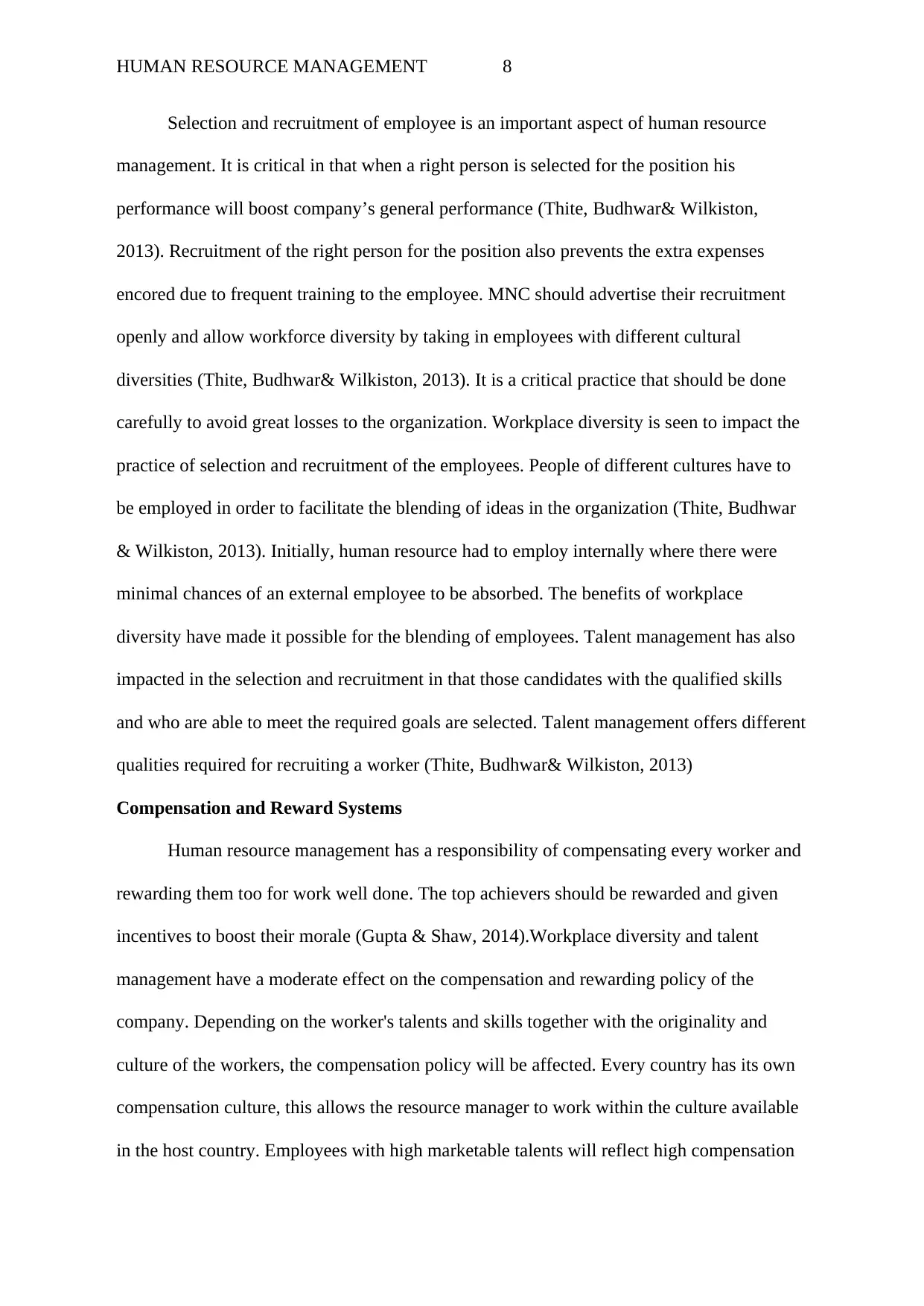
HUMAN RESOURCE MANAGEMENT 8
Selection and recruitment of employee is an important aspect of human resource
management. It is critical in that when a right person is selected for the position his
performance will boost company’s general performance (Thite, Budhwar& Wilkiston,
2013). Recruitment of the right person for the position also prevents the extra expenses
encored due to frequent training to the employee. MNC should advertise their recruitment
openly and allow workforce diversity by taking in employees with different cultural
diversities (Thite, Budhwar& Wilkiston, 2013). It is a critical practice that should be done
carefully to avoid great losses to the organization. Workplace diversity is seen to impact the
practice of selection and recruitment of the employees. People of different cultures have to
be employed in order to facilitate the blending of ideas in the organization (Thite, Budhwar
& Wilkiston, 2013). Initially, human resource had to employ internally where there were
minimal chances of an external employee to be absorbed. The benefits of workplace
diversity have made it possible for the blending of employees. Talent management has also
impacted in the selection and recruitment in that those candidates with the qualified skills
and who are able to meet the required goals are selected. Talent management offers different
qualities required for recruiting a worker (Thite, Budhwar& Wilkiston, 2013)
Compensation and Reward Systems
Human resource management has a responsibility of compensating every worker and
rewarding them too for work well done. The top achievers should be rewarded and given
incentives to boost their morale (Gupta & Shaw, 2014).Workplace diversity and talent
management have a moderate effect on the compensation and rewarding policy of the
company. Depending on the worker's talents and skills together with the originality and
culture of the workers, the compensation policy will be affected. Every country has its own
compensation culture, this allows the resource manager to work within the culture available
in the host country. Employees with high marketable talents will reflect high compensation
Selection and recruitment of employee is an important aspect of human resource
management. It is critical in that when a right person is selected for the position his
performance will boost company’s general performance (Thite, Budhwar& Wilkiston,
2013). Recruitment of the right person for the position also prevents the extra expenses
encored due to frequent training to the employee. MNC should advertise their recruitment
openly and allow workforce diversity by taking in employees with different cultural
diversities (Thite, Budhwar& Wilkiston, 2013). It is a critical practice that should be done
carefully to avoid great losses to the organization. Workplace diversity is seen to impact the
practice of selection and recruitment of the employees. People of different cultures have to
be employed in order to facilitate the blending of ideas in the organization (Thite, Budhwar
& Wilkiston, 2013). Initially, human resource had to employ internally where there were
minimal chances of an external employee to be absorbed. The benefits of workplace
diversity have made it possible for the blending of employees. Talent management has also
impacted in the selection and recruitment in that those candidates with the qualified skills
and who are able to meet the required goals are selected. Talent management offers different
qualities required for recruiting a worker (Thite, Budhwar& Wilkiston, 2013)
Compensation and Reward Systems
Human resource management has a responsibility of compensating every worker and
rewarding them too for work well done. The top achievers should be rewarded and given
incentives to boost their morale (Gupta & Shaw, 2014).Workplace diversity and talent
management have a moderate effect on the compensation and rewarding policy of the
company. Depending on the worker's talents and skills together with the originality and
culture of the workers, the compensation policy will be affected. Every country has its own
compensation culture, this allows the resource manager to work within the culture available
in the host country. Employees with high marketable talents will reflect high compensation
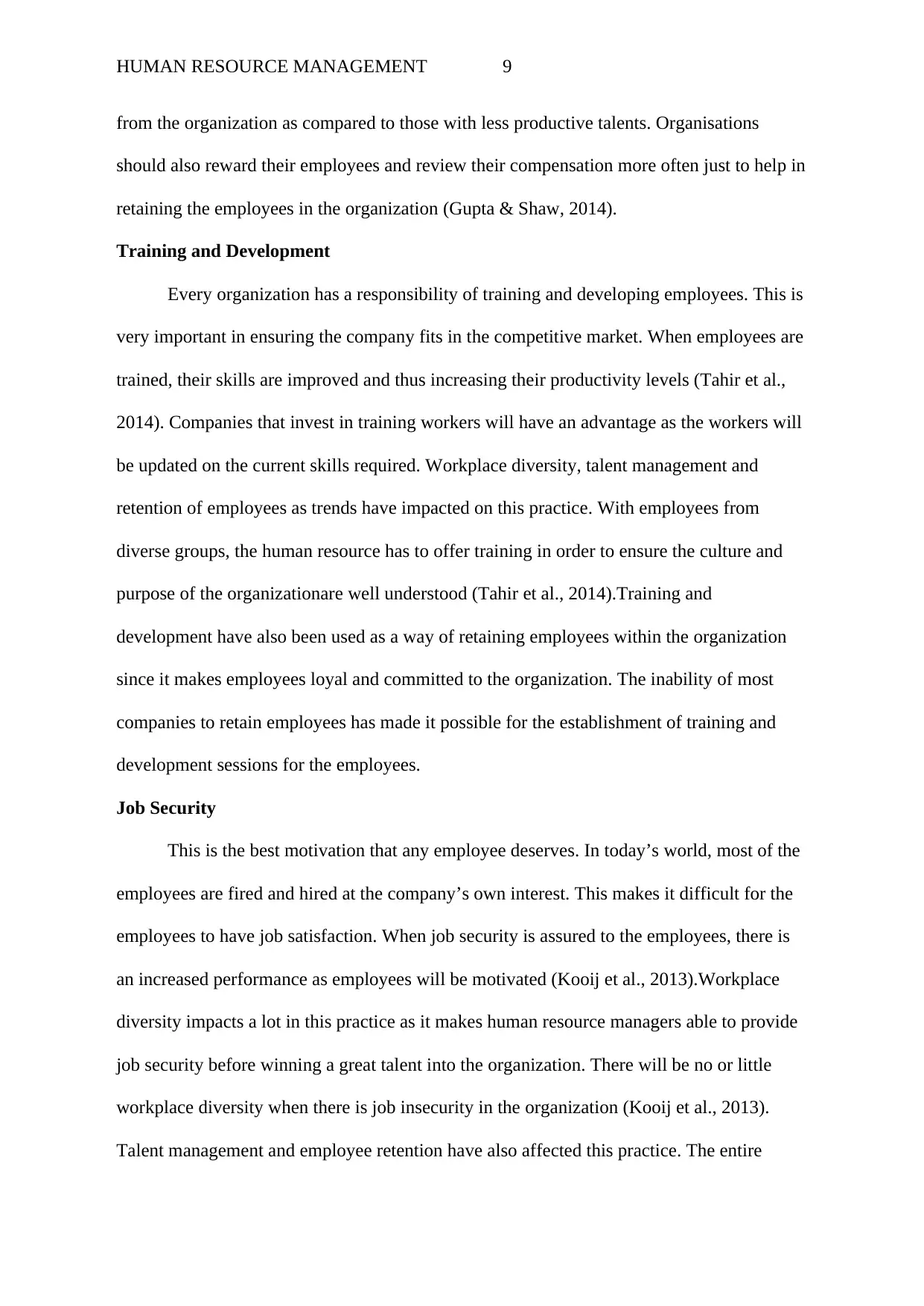
HUMAN RESOURCE MANAGEMENT 9
from the organization as compared to those with less productive talents. Organisations
should also reward their employees and review their compensation more often just to help in
retaining the employees in the organization (Gupta & Shaw, 2014).
Training and Development
Every organization has a responsibility of training and developing employees. This is
very important in ensuring the company fits in the competitive market. When employees are
trained, their skills are improved and thus increasing their productivity levels (Tahir et al.,
2014). Companies that invest in training workers will have an advantage as the workers will
be updated on the current skills required. Workplace diversity, talent management and
retention of employees as trends have impacted on this practice. With employees from
diverse groups, the human resource has to offer training in order to ensure the culture and
purpose of the organizationare well understood (Tahir et al., 2014).Training and
development have also been used as a way of retaining employees within the organization
since it makes employees loyal and committed to the organization. The inability of most
companies to retain employees has made it possible for the establishment of training and
development sessions for the employees.
Job Security
This is the best motivation that any employee deserves. In today’s world, most of the
employees are fired and hired at the company’s own interest. This makes it difficult for the
employees to have job satisfaction. When job security is assured to the employees, there is
an increased performance as employees will be motivated (Kooij et al., 2013).Workplace
diversity impacts a lot in this practice as it makes human resource managers able to provide
job security before winning a great talent into the organization. There will be no or little
workplace diversity when there is job insecurity in the organization (Kooij et al., 2013).
Talent management and employee retention have also affected this practice. The entire
from the organization as compared to those with less productive talents. Organisations
should also reward their employees and review their compensation more often just to help in
retaining the employees in the organization (Gupta & Shaw, 2014).
Training and Development
Every organization has a responsibility of training and developing employees. This is
very important in ensuring the company fits in the competitive market. When employees are
trained, their skills are improved and thus increasing their productivity levels (Tahir et al.,
2014). Companies that invest in training workers will have an advantage as the workers will
be updated on the current skills required. Workplace diversity, talent management and
retention of employees as trends have impacted on this practice. With employees from
diverse groups, the human resource has to offer training in order to ensure the culture and
purpose of the organizationare well understood (Tahir et al., 2014).Training and
development have also been used as a way of retaining employees within the organization
since it makes employees loyal and committed to the organization. The inability of most
companies to retain employees has made it possible for the establishment of training and
development sessions for the employees.
Job Security
This is the best motivation that any employee deserves. In today’s world, most of the
employees are fired and hired at the company’s own interest. This makes it difficult for the
employees to have job satisfaction. When job security is assured to the employees, there is
an increased performance as employees will be motivated (Kooij et al., 2013).Workplace
diversity impacts a lot in this practice as it makes human resource managers able to provide
job security before winning a great talent into the organization. There will be no or little
workplace diversity when there is job insecurity in the organization (Kooij et al., 2013).
Talent management and employee retention have also affected this practice. The entire
⊘ This is a preview!⊘
Do you want full access?
Subscribe today to unlock all pages.

Trusted by 1+ million students worldwide
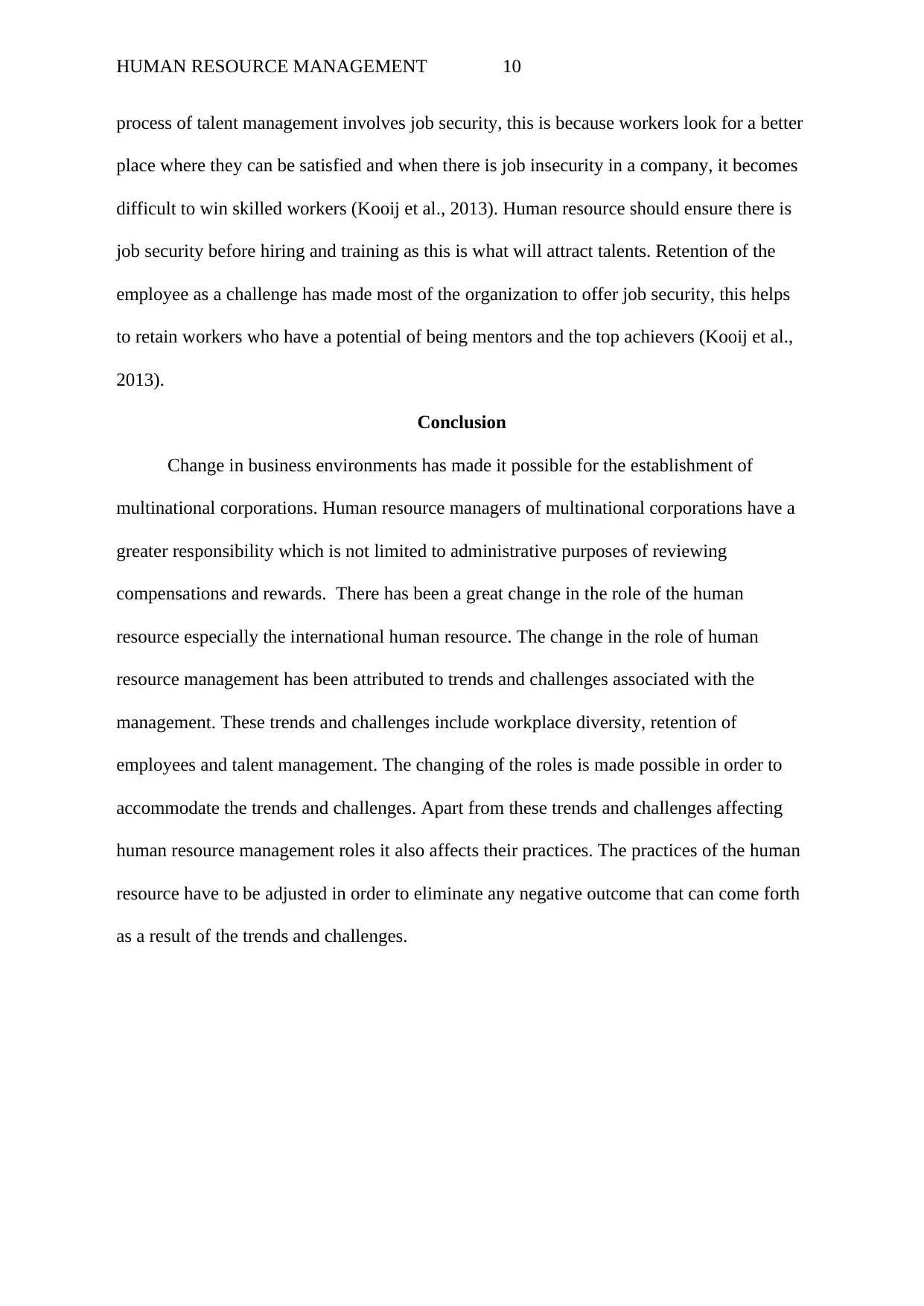
HUMAN RESOURCE MANAGEMENT 10
process of talent management involves job security, this is because workers look for a better
place where they can be satisfied and when there is job insecurity in a company, it becomes
difficult to win skilled workers (Kooij et al., 2013). Human resource should ensure there is
job security before hiring and training as this is what will attract talents. Retention of the
employee as a challenge has made most of the organization to offer job security, this helps
to retain workers who have a potential of being mentors and the top achievers (Kooij et al.,
2013).
Conclusion
Change in business environments has made it possible for the establishment of
multinational corporations. Human resource managers of multinational corporations have a
greater responsibility which is not limited to administrative purposes of reviewing
compensations and rewards. There has been a great change in the role of the human
resource especially the international human resource. The change in the role of human
resource management has been attributed to trends and challenges associated with the
management. These trends and challenges include workplace diversity, retention of
employees and talent management. The changing of the roles is made possible in order to
accommodate the trends and challenges. Apart from these trends and challenges affecting
human resource management roles it also affects their practices. The practices of the human
resource have to be adjusted in order to eliminate any negative outcome that can come forth
as a result of the trends and challenges.
process of talent management involves job security, this is because workers look for a better
place where they can be satisfied and when there is job insecurity in a company, it becomes
difficult to win skilled workers (Kooij et al., 2013). Human resource should ensure there is
job security before hiring and training as this is what will attract talents. Retention of the
employee as a challenge has made most of the organization to offer job security, this helps
to retain workers who have a potential of being mentors and the top achievers (Kooij et al.,
2013).
Conclusion
Change in business environments has made it possible for the establishment of
multinational corporations. Human resource managers of multinational corporations have a
greater responsibility which is not limited to administrative purposes of reviewing
compensations and rewards. There has been a great change in the role of the human
resource especially the international human resource. The change in the role of human
resource management has been attributed to trends and challenges associated with the
management. These trends and challenges include workplace diversity, retention of
employees and talent management. The changing of the roles is made possible in order to
accommodate the trends and challenges. Apart from these trends and challenges affecting
human resource management roles it also affects their practices. The practices of the human
resource have to be adjusted in order to eliminate any negative outcome that can come forth
as a result of the trends and challenges.
Paraphrase This Document
Need a fresh take? Get an instant paraphrase of this document with our AI Paraphraser
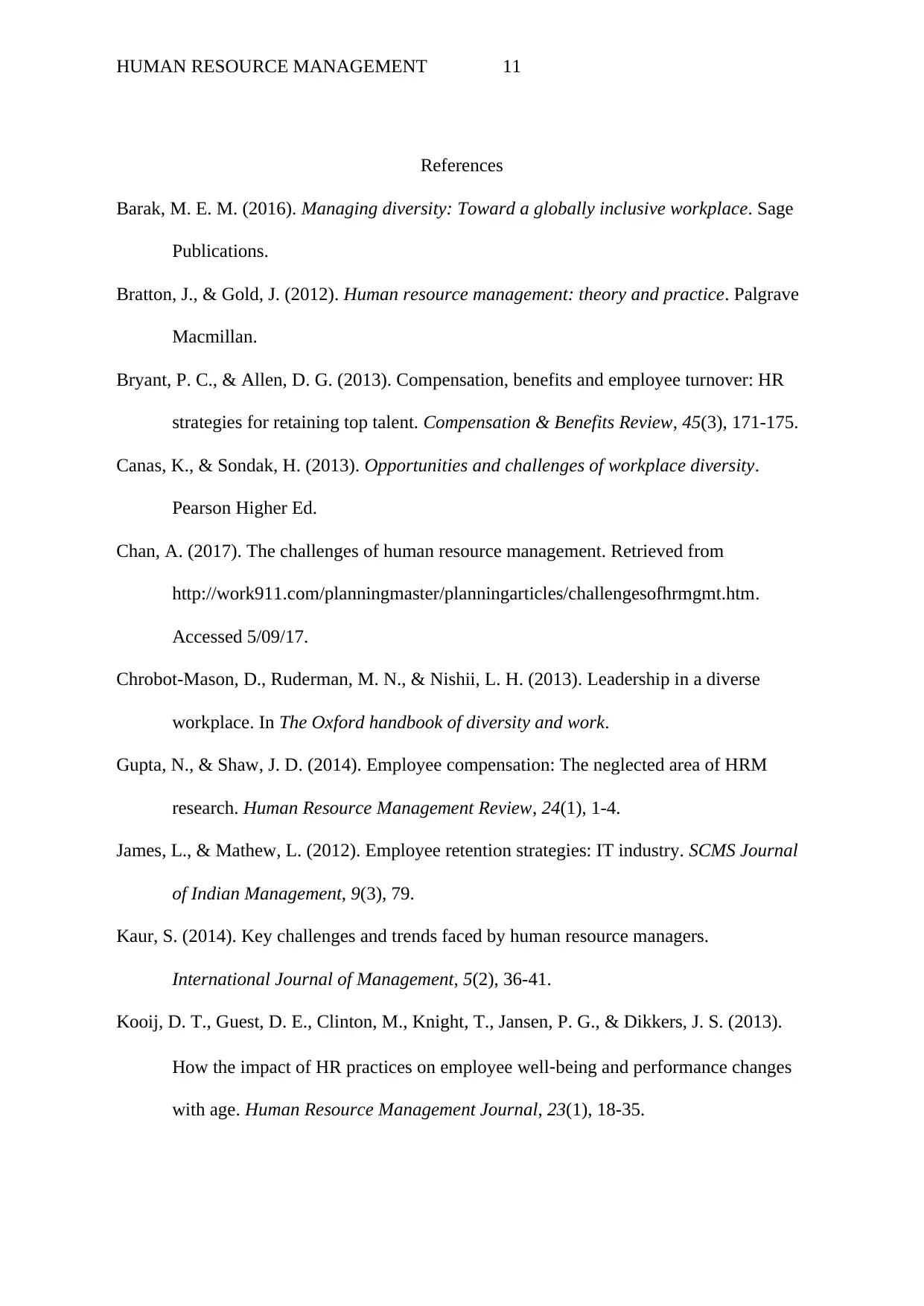
HUMAN RESOURCE MANAGEMENT 11
References
Barak, M. E. M. (2016). Managing diversity: Toward a globally inclusive workplace. Sage
Publications.
Bratton, J., & Gold, J. (2012). Human resource management: theory and practice. Palgrave
Macmillan.
Bryant, P. C., & Allen, D. G. (2013). Compensation, benefits and employee turnover: HR
strategies for retaining top talent. Compensation & Benefits Review, 45(3), 171-175.
Canas, K., & Sondak, H. (2013). Opportunities and challenges of workplace diversity.
Pearson Higher Ed.
Chan, A. (2017). The challenges of human resource management. Retrieved from
http://work911.com/planningmaster/planningarticles/challengesofhrmgmt.htm.
Accessed 5/09/17.
Chrobot-Mason, D., Ruderman, M. N., & Nishii, L. H. (2013). Leadership in a diverse
workplace. In The Oxford handbook of diversity and work.
Gupta, N., & Shaw, J. D. (2014). Employee compensation: The neglected area of HRM
research. Human Resource Management Review, 24(1), 1-4.
James, L., & Mathew, L. (2012). Employee retention strategies: IT industry. SCMS Journal
of Indian Management, 9(3), 79.
Kaur, S. (2014). Key challenges and trends faced by human resource managers.
International Journal of Management, 5(2), 36-41.
Kooij, D. T., Guest, D. E., Clinton, M., Knight, T., Jansen, P. G., & Dikkers, J. S. (2013).
How the impact of HR practices on employee well‐being and performance changes
with age. Human Resource Management Journal, 23(1), 18-35.
References
Barak, M. E. M. (2016). Managing diversity: Toward a globally inclusive workplace. Sage
Publications.
Bratton, J., & Gold, J. (2012). Human resource management: theory and practice. Palgrave
Macmillan.
Bryant, P. C., & Allen, D. G. (2013). Compensation, benefits and employee turnover: HR
strategies for retaining top talent. Compensation & Benefits Review, 45(3), 171-175.
Canas, K., & Sondak, H. (2013). Opportunities and challenges of workplace diversity.
Pearson Higher Ed.
Chan, A. (2017). The challenges of human resource management. Retrieved from
http://work911.com/planningmaster/planningarticles/challengesofhrmgmt.htm.
Accessed 5/09/17.
Chrobot-Mason, D., Ruderman, M. N., & Nishii, L. H. (2013). Leadership in a diverse
workplace. In The Oxford handbook of diversity and work.
Gupta, N., & Shaw, J. D. (2014). Employee compensation: The neglected area of HRM
research. Human Resource Management Review, 24(1), 1-4.
James, L., & Mathew, L. (2012). Employee retention strategies: IT industry. SCMS Journal
of Indian Management, 9(3), 79.
Kaur, S. (2014). Key challenges and trends faced by human resource managers.
International Journal of Management, 5(2), 36-41.
Kooij, D. T., Guest, D. E., Clinton, M., Knight, T., Jansen, P. G., & Dikkers, J. S. (2013).
How the impact of HR practices on employee well‐being and performance changes
with age. Human Resource Management Journal, 23(1), 18-35.
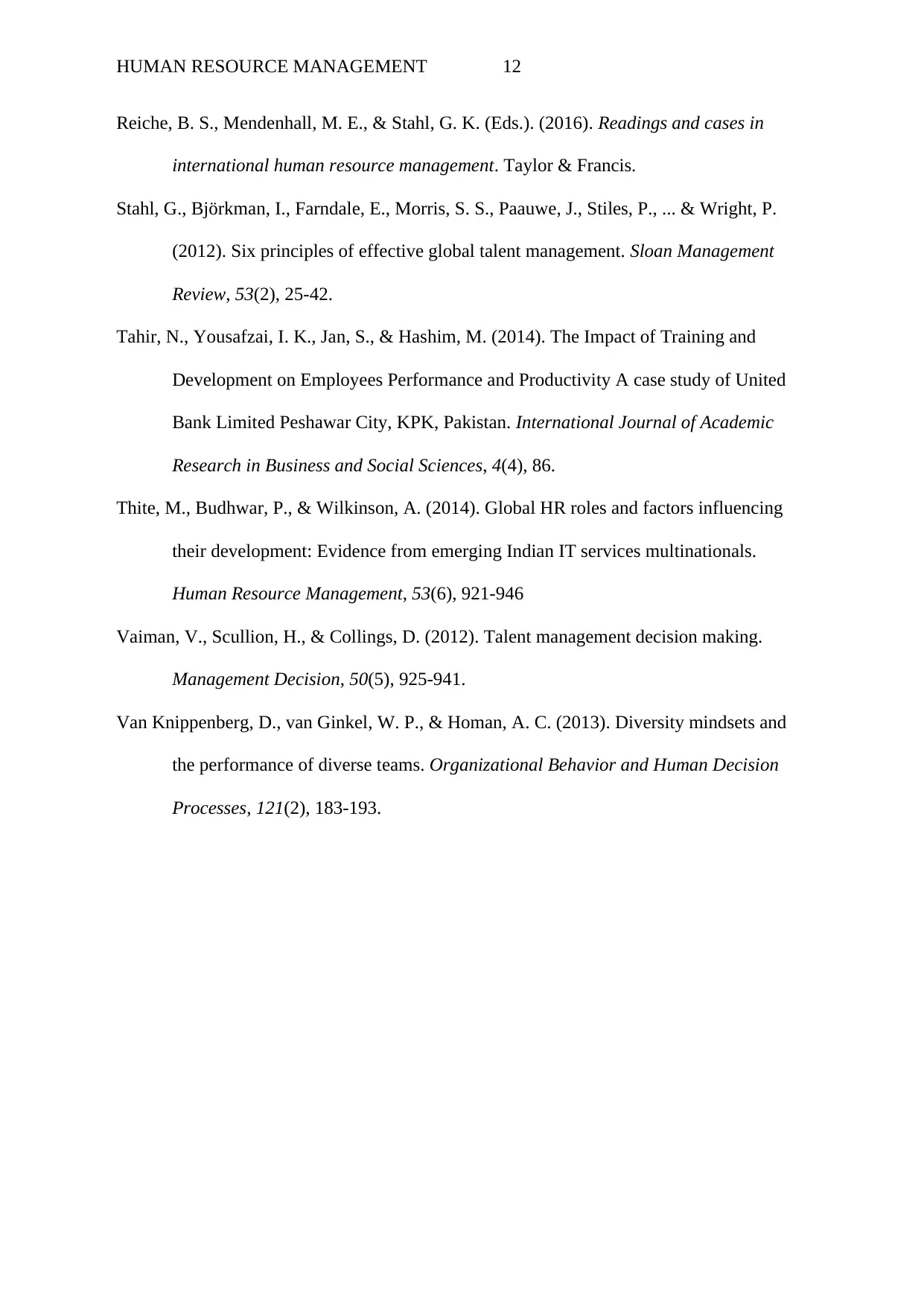
HUMAN RESOURCE MANAGEMENT 12
Reiche, B. S., Mendenhall, M. E., & Stahl, G. K. (Eds.). (2016). Readings and cases in
international human resource management. Taylor & Francis.
Stahl, G., Björkman, I., Farndale, E., Morris, S. S., Paauwe, J., Stiles, P., ... & Wright, P.
(2012). Six principles of effective global talent management. Sloan Management
Review, 53(2), 25-42.
Tahir, N., Yousafzai, I. K., Jan, S., & Hashim, M. (2014). The Impact of Training and
Development on Employees Performance and Productivity A case study of United
Bank Limited Peshawar City, KPK, Pakistan. International Journal of Academic
Research in Business and Social Sciences, 4(4), 86.
Thite, M., Budhwar, P., & Wilkinson, A. (2014). Global HR roles and factors influencing
their development: Evidence from emerging Indian IT services multinationals.
Human Resource Management, 53(6), 921-946
Vaiman, V., Scullion, H., & Collings, D. (2012). Talent management decision making.
Management Decision, 50(5), 925-941.
Van Knippenberg, D., van Ginkel, W. P., & Homan, A. C. (2013). Diversity mindsets and
the performance of diverse teams. Organizational Behavior and Human Decision
Processes, 121(2), 183-193.
Reiche, B. S., Mendenhall, M. E., & Stahl, G. K. (Eds.). (2016). Readings and cases in
international human resource management. Taylor & Francis.
Stahl, G., Björkman, I., Farndale, E., Morris, S. S., Paauwe, J., Stiles, P., ... & Wright, P.
(2012). Six principles of effective global talent management. Sloan Management
Review, 53(2), 25-42.
Tahir, N., Yousafzai, I. K., Jan, S., & Hashim, M. (2014). The Impact of Training and
Development on Employees Performance and Productivity A case study of United
Bank Limited Peshawar City, KPK, Pakistan. International Journal of Academic
Research in Business and Social Sciences, 4(4), 86.
Thite, M., Budhwar, P., & Wilkinson, A. (2014). Global HR roles and factors influencing
their development: Evidence from emerging Indian IT services multinationals.
Human Resource Management, 53(6), 921-946
Vaiman, V., Scullion, H., & Collings, D. (2012). Talent management decision making.
Management Decision, 50(5), 925-941.
Van Knippenberg, D., van Ginkel, W. P., & Homan, A. C. (2013). Diversity mindsets and
the performance of diverse teams. Organizational Behavior and Human Decision
Processes, 121(2), 183-193.
⊘ This is a preview!⊘
Do you want full access?
Subscribe today to unlock all pages.

Trusted by 1+ million students worldwide
1 out of 12
Related Documents
Your All-in-One AI-Powered Toolkit for Academic Success.
+13062052269
info@desklib.com
Available 24*7 on WhatsApp / Email
![[object Object]](/_next/static/media/star-bottom.7253800d.svg)
Unlock your academic potential
Copyright © 2020–2025 A2Z Services. All Rights Reserved. Developed and managed by ZUCOL.





